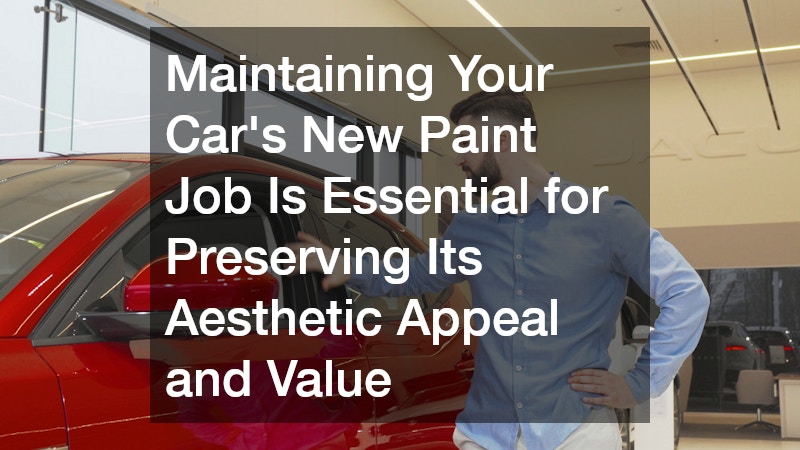After having your car freshly painted, it’s important to know how to maintain that crisp, new look. Proper care will ensure your vehicle looks its best for years to come. This article covers the most essential tips for maintaining your car post-paint job.
1. How Long Should You Wait Before Washing Your Car?
1.1 The Ideal Waiting Period
The freshly applied paint needs time to cure and harden, usually requiring at least two weeks of waiting before it can handle a wash. This period allows solvents in the paint to evaporate completely, solidifying the paint surface adequately.
Rushing to wash your car too soon can lead to unwanted blemishes or even peeling paint. It’s essential to adhere to the recommended waiting period to preserve the paint’s integrity.
Consult with your auto painting service to confirm the specific recommendations suited to your vehicle and paint type. In some cases, the climatic conditions may also affect the curing process.
1.2 Tips for the First Wash
Once your car is ready for its initial wash, use a gentle automotive soap that avoids harsh chemicals or abrasive ingredients. Opt for a clean, soft cloth or microfiber towel to apply the soap and rinse thoroughly.
Use only lukewarm water, as excessively hot or cold water can stress the new paint. Avoid automatic car washes as their brushes and harsh detergents can be too aggressive for newly painted surfaces.
Pay special attention to areas where water can pool, as this can affect the paint’s finish. Dry the car completely to prevent water spots that can mar the surface.
2. What Are the Best Waxing Practices for a Recently Painted Car?
2.1 Timing Your First Wax
When deciding on the right time to wax your newly painted car, patience is key; ideally, you should wait around 60 days. This duration allows the paint to fully cure and reach its optimum hardness before a protective layer is applied.
Waxing too soon can trap solvents in the paint, leading to a cloudy appearance or even affecting the paint’s adhesion. Always follow the guidance provided by your auto body shop regarding waxing timelines.
Routine waxing thereafter can provide invaluable protection, shielding the paint from minor scratches and fading. You should aim to wax your car every 3-4 months.
2.2 Choosing the Right Wax
Selecting the right wax is crucial; opt for a product specifically meant for new or fresh paint. Synthetic waxes often offer longer-lasting protection than natural waxes and are easier to apply evenly.
Carnauba wax, though more traditional, gives an excellent glossy finish but might require more frequent reapplication. Balance your selection according to the environment your vehicle is typically exposed to.
Your choice of wax can greatly influence the car’s appearance and longevity of protection, so choose thoughtfully. Rely on professional or well-reviewed products to ensure quality results.
3. How to Protect the Paint in Different Weather Conditions?
3.1 Guarding Against Sun Damage
Prolonged exposure to sunlight can deteriorate your car’s paint, causing it to fade and lose its luster. Utilizing UV protectants extends the life of the paint by reflecting harmful rays.
Parking your vehicle in shaded areas or using a car cover when appropriate can dramatically reduce sun exposure. Adding a layer of wax also helps protect against the sun’s harshness.
A proactive approach will maintain your car’s vibrant color and strong protective clear coat. Regular inspections for early signs of fading can help mitigate damage.
3.2 Shielding from Rain and Snow
Rainwater can be acidic, which poses a threat to your car’s paint job. Regular cleanings will prevent any harmful deposits from sitting on your vehicle’s surface.
In snowy conditions, road salt and grit can chip and corrode paintwork quickly. After snow exposure, cleaning your vehicle promptly is vital to minimizing accumulated risk.
Consider applying a high-quality sealant for added defense against moisture-induced damage. These protectants create a waterproof barrier that ensures lasting durability.
4. How Can You Avoid Common Paint Damaging Mistakes?
4.1 Avoiding Harsh Chemicals
The use of unsuitable cleaning products can lead to irreparable damage to your paint job. Avoid acids, ammonia, or bleach-based substances, which can weaken the paint’s bond.
Invest in pH-balanced car washing products designed for delicate paint care. These formulations ensure a thorough clean without compromising the paint’s quality.
Reading labels and recommendations carefully ensures that only the safest products are used on your vehicle. Professional advice is always helpful when in doubt.
4.2 Preventing Physical Damage
Physical impacts, no matter how minor, can introduce scratches and blemishes. Use a car cover for added protection when parked in high-traffic areas.
Strategic parking practices, such as choosing end spaces or spots away from shopping carts, can prevent accidental damage. Protective measures greatly reduce paint repair frequency and cost.
Maintaining an awareness of your surrounding environment while driving can shield your car from debris and other potential hazards. Vigilance is key in preserving paint integrity.
Maintaining your car’s new paint job is essential for preserving its aesthetic appeal and value. By following these guidelines on washing, waxing, and protecting against environmental factors, you can ensure your car remains looking brand new for as long as possible.




